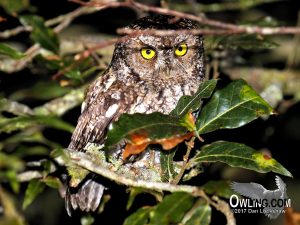 It’s taken me 15 years to finally get brave enough to return to Chiapas in search of the resident owls. Bordering Guatemala in the south of Mexico is the state of Chiapas. This is an important destination to see the owls of Central America. Chiapas host more species of owls than any other state in Mexico. The species of this area are also critical to our understanding of taxonomy as it relates to the owls. Slowly, owl taxonomy is becoming better understood with much cleaner and more complete definitions being sorted out by science including new divisions that classify them in better clarity.
It’s taken me 15 years to finally get brave enough to return to Chiapas in search of the resident owls. Bordering Guatemala in the south of Mexico is the state of Chiapas. This is an important destination to see the owls of Central America. Chiapas host more species of owls than any other state in Mexico. The species of this area are also critical to our understanding of taxonomy as it relates to the owls. Slowly, owl taxonomy is becoming better understood with much cleaner and more complete definitions being sorted out by science including new divisions that classify them in better clarity.
Chiapas
The wildlife of Chiapas is exceptional and the Mayan ruins are a draw to tourists from around the world. Away from the manicured tourist areas, habitat destruction is rampant, the people are poor, pollution is intense, and travel can be dangerous for westerners. The rich natural wealth of Chiapas is impressive, but with a corrupt system and explosive population growth it seems it may eventually all disappear. Having traveled much of Central America, I was disappointed that things have not improved since I was last here.
Based on past experience here, I hired a guide and brought a friend to mitigate the risks. Our guide, Alberto, was exceptional, well educated, spoke English, knew not only the owls but was impressive in his knowledge of all the wildlife. In nine days, we documented (photographed, videoed, and recorded) nine species of owls and over a hundred and eighty species of mammals and birds in the daytime.
The Owls
Chiapas hosts 19 species of owls. Although none of these are endemic, no other state in Mexico can match this number of species. Furthermore, there are species here that are difficult to find anywhere outside Chiapas or Guatemala and travel within Guatemala may be more dangerous yet. Below is a list of the 19 species of owls recorded in Chiapas.
| STRIGIFORMES: Tytonidae | ||
| American Barn Owl | Tyto alba | |
| STRIGIFORMES: Strigidae | ||
| Flammulated Owl | Psiloscops flammeolus | |
| Pacific Screech Owl | Megascops cooperi | |
| Whiskered Screech Owl | Megascops trichopsis | |
| Bearded Screech Owl | Megascops barbarus | |
| Guatemalan Screech Owl | Megascops guatemalae | |
| Great Horned Owl | Bubo virginianus | |
| Mexican Wood Owl | Strix squamulata | |
| Black-and-white Owl | Ciccaba nigrolineata | |
| Fulvous Owl | Strix fulvescens | |
| Crested Owl | Lophostrix cristata | |
| Spectacled Owl | Pulsatrix perspicillata | |
| Guatemalan Pygmy-Owl | Glaucidium cobanense | |
| Central American Pygmy-Owl | Glaucidium griseiceps | |
| Ridgway’s Pygmy-Owl | Glaucidium brasilianum | |
| Burrowing Owl | Athene cunicularia | |
| Unspotted Saw-whet Owl | Aegolius ridgwayi | |
| Stygian Owl | Asio stygius | |
| Striped Owl | Asio clamator | |
 Unspotted Saw-whet Owl
Unspotted Saw-whet Owl
We prioritized our searches for the species that would be difficult to find in other locations. With nine nights available, our primary target was the Unspotted Saw-whet Owl. On previous trips to Chiapas, Guatemala, and Costa Rica I have never managed to take photos of this species. We spent four of our nine nights primarily searching for this owl. Our dedication paid off and we did finally manage to document two Unspotted Saw-whet Owls. Both owls were found at over 8,000 feet in the high elevation cloud forests north of San Cristobal de las Casas. My only disappointment was missing a photo of the one that flew up and landed on our guide’s head!
Range and Status
Unspotted Saw-whet Owl is known from Mexico, Guatemala, Nicaragua, Costa Rica, and Western Panama. In Mexico, they are considered critically endangered. The species lives in scattered and frequently remote, high-elevation cloud forests. They are not a sociable species, are randomly dispersed, and only vocalize for a short period of the year so accurate population estimates for this species in Central America are just not possible. Because of their solitary lives and subsequent low density, even with a larger range than some of the Central American owls, their total numbers are invariably lower than is thought.
Concerns
The dangers to Unspotted Saw-whet Owl in Central America are difficult topics with few simple solutions. High population growths, unregulated forest development, habitat destruction for agriculture and fuel are but just a few of the dangers this species faces. In Chiapas, the air quality was poor from the burning of wood for fuel. The people are very protective of their land and highly opposed to regulation. The clear majority of the population lives on a very meager existence. For nature, this spells doom. The nocturnal owls are always at risk since they are seldom seen, often a target of superstitious beliefs, and their needs are not well understood.
 Guatemalan Pygmy-Owl
Guatemalan Pygmy-Owl
The next owl species on our list was the Guatemalan Pygmy-Owl. This species was fairly recently divided from the Mountain Pygmy-Owl. It is also a high elevation species that we found at over 8,000 feet in the cloud forests above San Cristobal. The range of Guatemalan Pygmy-Owl is limited to Mexico, Guatemala, and possibly into Nicaragua. Current research has split this owl from Mountain Pygmy-Owl based on DNA, vocal differences, and geographic separation. After seeing this species, we agree and have separated these two species on the owling.com website. Like the Mountain Pygmy-Owl, this is a very small sparrow sized, diurnal (active in the day) species. On this particular trip, the owl was difficult to find, mostly high up in the dry forest canopy, and not overly obliging to our photography. I look forward to getting more experience with this species in the future.
 Bearded Screech-Owl
Bearded Screech-Owl
Another very limited range species that took high precedence in our searches was the Bearded Screech-Owl. Contrary to our other major targets, finding this cute little screech-owl was fairly simple. On my last trip into this area I had found this species at much lower elevations, although I was specifically looking for it. Contrary to this, on this trip we spent more time at higher elevations looking for Unspotted Saw-whet Owl.
The Bearded Screech-Owls were usually present and fairly simple to find. Like most screech-owls, they are somewhat colonial and live in loose groups. When we heard this owl, it was generally easy to find a few of them. The red morph slightly outnumbered the brown morph and our guide confirmed this was the case within the general population. This also makes it particularly susceptible to the threats of deforestation. Since it has range limited to the highlands of Chiapas and Guatemala, this species is very vulnerable.
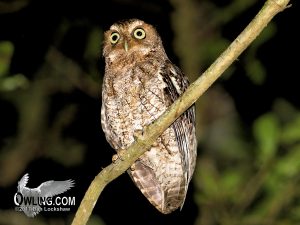 Guatemalan Screech-Owl
Guatemalan Screech-Owl
The next priority on our list might seem somewhat a surprise and on my previous trip into Chiapas I did not search for this owl at all. This being the Guatemalan Screech-Owl. The species has an extensive range stretching from northeast Mexico to Nicaragua. I’ve heard this owl many more times than seen it. It is very secretive and timid. Yes, some people stumble upon this owl with ease, in some places, during the right season or moon phase or who knows how, but that is not the norm.
Having discussed this owl with our guide, his claims were that it was easily found in the Naha area. My predictions sadly came true and managing to photograph one of these in thick rain forest habitats would not happen on our first stay in Naha. Being very determined, especially after hearing several owls and even seeing them at a distance on our first visit, we scheduled a second night in Naha at the end of our trip to try again.
Success
Guatemalan Screech-Owl has one of the most ventriloquial vocalizations of any owl and locating it by sound is extremely difficult. There were certainly many of them in forests around the Naha area. About the time I thought we were going to miss taking pictures of this owl a second time, we ran across the individual that I hear about everybody else seeing.
Having the ability to see one of these up close was fortunate for multiple reasons. The race in the south is very different visually from the race in the north of its range. The habitat here is different, much wetter, and the forests more tropical than in the dryer north. The northern race has distinctive black outline to its facial disk, distinct white eyebrows and is lightly marked on its underside. This southern race has very little black border to its facial disk, nondescript lighter eyebrows and is heavily marked on its chest and belly. This is a perfect example of why owls are defined by vocalization.
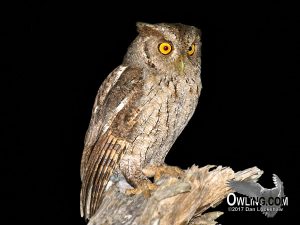 Pacific Screech-Owl
Pacific Screech-Owl
Since I had been to Oaxaca recently to document the newly defined Oaxaca Screech-Owl I wanted to document Pacific Screech-Owl from the border area of Chiapas. The Oaxaca Screech-Owl in recent years has been separated by most authors from the Pacific Screech-Owl. Visually, behaviorally, and vocally these two species are very different.
The Pacific Screech-Owl has a very narrow range along the coastline from northern Costa Rica to Southern Oaxaca. Coastline property is valuable real estate so the pressure to this species habitat is very high. As I expected, the owl was fairly easy to find but not for the reason I expected. In our short time along the coast the potential habitat was so small this species was easy to find. The development of the area, since I had last been there, was frightening. I was looking forward to getting into nice clean coastal air but was sadly disappointed.
 Ridgway’s (Ferruginous) Pygmy-Owl
Ridgway’s (Ferruginous) Pygmy-Owl
The next priorities for us in this region were Black-and-white Owl and Crested Owl. The best places to find these are on the Caribbean side of Chiapas. Since we had also seen reports of these near Palenque we decided to try this area. Getting there late in the day, we got a hotel down the road from the ruins with plans to search the area at night. As we arrived a couple other guests seeing our camera equipment asked us what we were there for. Timing couldn’t have been better for a Ridgway’s (Ferruginous) Pygmy-Owl to fly over and land in the tree above us. As they were telling us they had never seen an owl and didn’t know that owls were there, it was ideal to show them the owl that just landed over their heads.
Listening
This is also an example of listening. We recognized the owl flying in over our heads by sound. Owling is about sounds. The owls find each other by sound. It is what drives speciation and determines what an owl is. As we noted above how different the two races of Guatemalan Screech-Owls are in appearance. They sound the same.
Name Change
As a note, the name Ridgway’s Pygmy-Owl may seem different to readers here. Because of vocalizations, Ferruginous Pygmy-Owl has been split and the South American owl retained the name. This will be more commonly used as it becomes standard in the field guides. We also see this with the Guatemalan Pygmy-Owl that has been recently split from Mountain Pygmy-Owl, also primarily based on vocalizations. We highly support these splits. It reflects the growing knowledge of the owls in Mexico and Central America, helps to safeguard unique species, and protect our worlds biodiversity. There is a lot of money and pressure devoted to preventing clear definitions of nature.
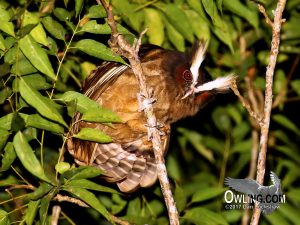 Crested Owl
Crested Owl
Getting back to the owls in the Palenque area, after getting settled in our room, we headed out to the areas that were accessible to us on the roads below the ruins. In a fairly limited period of time we found multiple Crested Owls. These are often seen on roosts in the daylight but not so often at night.
In speaking with local guides in Costa Rica, their claims have been that this species is very wary and seeing them at night just takes a lot of patience. We have had limited success with this species at night and getting good views of the owl can be difficult. My experiences with them in Costa Rica at night has often been frustrating. The owls usually stay high up in trees and mostly out of view. When we have had them come in close to us, it has often been for very brief periods. The Crested Owls around Palenque were much more visible.
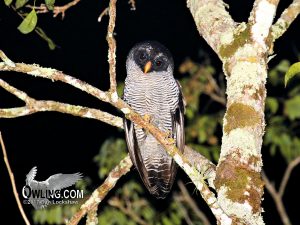 Black-and-white Owl
Black-and-white Owl
In our searches of the Palenque area we also found Black-and-white Owl. This was an expected owl of this area since I had seen them here before. This can be a very bold species, especially early in the evening. Having spent the first part of our night with the Crested Owls it was late at night before we found Black-and-white Owl. Although the owls were very visible, 20 feet up in the trees, it certainly was not like I have seen these before, in either Chiapas or Costa Rica. All considered, we had found three species of owls in one evening and we left with stories to be told. It was a good night of owling.
 Mexican Wood (Mottled) Owl
Mexican Wood (Mottled) Owl
The final owl species we found on this trip was a Mexican Wood (Mottled) Owl. Like Ridgway’s Pygmy-Owl above, Mexican Wood Owl is known to most of us as a Mottled Owl. It also has been split from a South American owl that retained the common name.
Above Arriaga we had gone into the El Ocote forest to see if we could also find the endangered Nava’s Wren (which we did). As night fell, several Mexican Wood Owls were present. There are two major color forms of Mexican Wood Owl. The lighter northern race and the darker southern race. The owls of this area were all the darker southern form. Some of the individuals were exceptionally dark in color that I thought was very interesting.
Conclusion
Our trip into Chiapas was by most measures fairly safe with only a few minor run-ins with the locals. Alberto, our guide, was a major factor in both finding what we went there for and in keeping the trip as safe as possible. His local knowledge, a command of the language, customs, and people was a major asset to us.
Chiapas itself is a bittersweet destination. The wildlife is exceptional and we hope that the future will somehow protect the life that is there, both people and nature. The protections of our home (earth) are so important. It’s a bit like your car running out of oil and deciding you’ll try to drive it for just a couple hundred miles more. Once we destroy wildlife it is gone, forever. We are in the process of making earth into a desert, for reasons that are crazy. Mankind must find a balance with nature. The owls are a major part of the balance of nature. The nighttime predator base subsequently keeps the daytime healthy. It is so easy to destroy that which is hidden at night. We know better in our world of information.


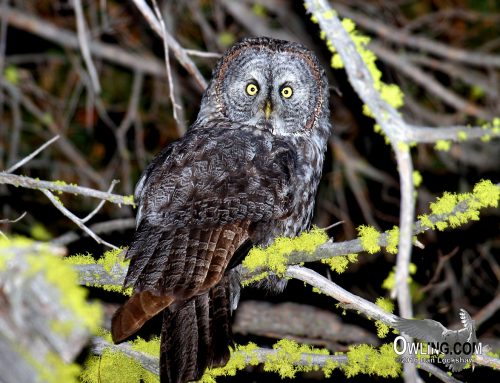
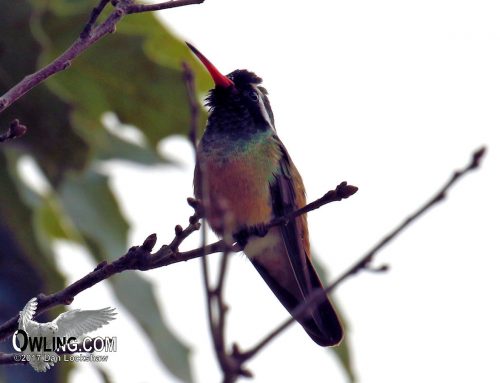
Leave A Comment
You must be logged in to post a comment.